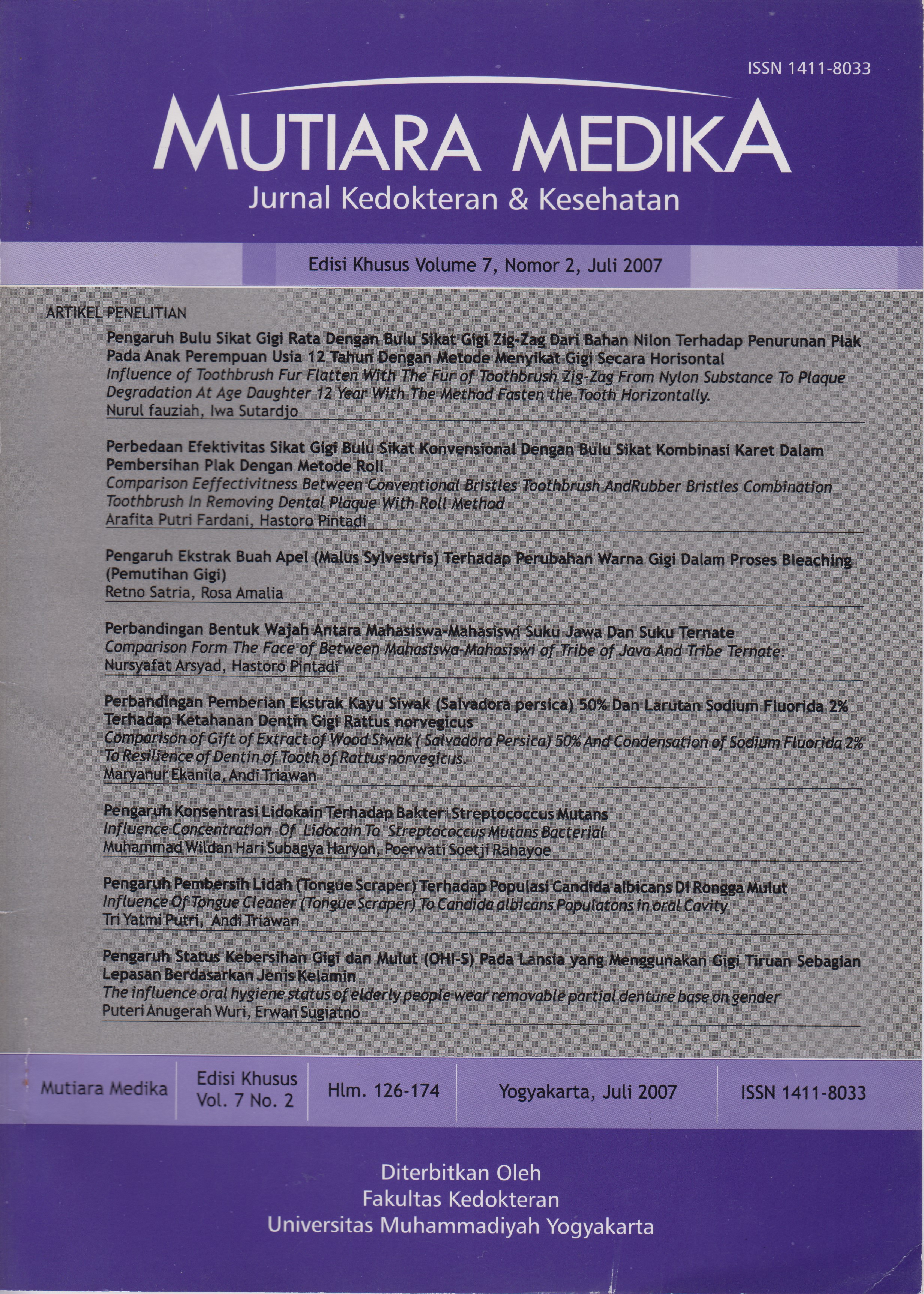Perbandingan Bentuk Wajah Antara Mahasiswa-Mahasiswi Suku Jawa Dan Suku Ternate
DOI:
https://doi.org/10.18196/mmjkk.v7i2%20(s).9428Keywords:
ethnic, facial index, raceAbstract
Java ethnic was Mongoloid race, while Ternate tribe was Austromelanesoid race. The aim of research is to compare facial indekx between Javaness and Ternateness by measuring the facial width and the facial height.
This research is cross sectional by the subject of research was 20 adult Javanese group and 20 adult Ternate etnic group whose live in Yogyakarta which each divided in 2 groups male and female. Influence variable is ethnic and to have influence variable is facial shape. Subject criteria which used was students in age 18-25 years old both from native Javanese and ternate etnic, which is not wear ortho appliance, in health condition and no facial deformity. The variable which uncontrolled was nutrition and bad habbit. The subject which fulfill measured their facial breadth and facial hight. Facial width measured from right zigion until left zigion use spreading caliper; and hight facial measured from nasion to gnathion uses sliding caliper: The result of width and hight facial was found from facial index which have been taken ration population from both ethnics. The result was measured analized useed t-tes.
The result showed that there was no significant diflerences facial index between those two etnic (p>0.05). Facial index between Javanese and Ternatenese male t=0.1 78, p=0.861. Facial index between Javenese and Ternatenese female t=1.283, p=0,216. from the result can be conclude that: 1). There is no differential hight and width facial between Javanese and T ernatenese female, 2). There no was differential hight and breadth facial between Javanese and Ternatenese male, 3). There was no differential facial index between Javanese and Ternatenese.
References
Enlow, D.H., 1990, Facial Growth, 3th ed, Philadelphia, W.B Saunders Company.
Foster, T. D., 1997, Buku Ajar Ortodonsi (terj), ed. 3, Jakarta, EGC
Glinka, J., 1990, Antropometri dan Antroposkopi, ed. 3, Surabaya, FISIP Universitas Airlangga.
Heryumani, JCP., 2006, Profil Wajah Orang Jawa Dewasa Berdasarkan Profil Hidung, dan Dagu, Jakarta, Indonesia Journal of Dentistry.
Jacob, T., 1973, Studi Tentang Variasi Manusia di Indonesia. Pidato pengukuhan Sebagai Guru Besar Dalam Ilmu Antripologi pada Fakultas Kedokteran Universitas Gajah Mada :10-3.
Jacob, T.,1999/2000, Buku Bacaan Antropologi Biologias, Et1y_Indriati. eds, Yogyakarta, Direktorat Jenderal Pendidikan Tinggi Departemen pendidikian Nasional.
Koentjaraningrat, 1990, Pengantar Ilmu Antropologi, Jakarta, P.T Rineka Cipta.
Moyers, R.E, 1973, Handbook of Orthodontics, 3 ed, USA, Year BookMedical Publisher.
Moyers, R.E, 1988, Handbook of Orthodontics, 4th edition, Year Book Medical Publisher, Inc, United State of America, p. 48-67.
Mudjosemedi, M., 2003, Bibir, Sidik Bibir, Ilmu Kesehatan dan Antropologi Ragawi: Integrasi Antara Teori dan Aplikasi, Yogyakarta, Banyu Biru Offset.
Park, l., Bowman, D. and Klapper, L., 1989, A Cepalomatric Study of Korea Adults, Am. J. Orthod. Dentofacial Orthop. 96 (1):54-9.
Salzman, 1957, Orthodontik Practice and Technics, Philadelphia, J.B Lippincott Company.
Sofwanhadi, R. and Abe, K., 2001, Cephalometric Survey On Tengger, Blitar, Kudus, and Cililian People, JKG Ul. 8 (3): 6-16.
Sukadana, A.A., 1976, Dasar-dasar Antropologi dan Phylogenesis Khusus untuk Ilmu Kedokteran Gigi Indonesia, Surabaya, FKG UNAIR.
Sperber, 1991 , Embriologi Kraniofasial, Jakarta, Hipokrates.
Van der Linden F.P.G.M., 1986, Facial Growth and Facial Orthopedics, Quintessence, Publishing, Chicago, pp. 184- 194.
Weiner, J . S, Tanner, J. M, and Barnicot, N. A, 1977, Human Biologi. An Introduction To Human Evolution, Variasi, Growth, and Ecologi. 2nd ed., Oxford university press.
Yuwono, L., 1993, Buku pintarAnatomi Kedokteran Gigi, Jakarta, EGC
Downloads
Published
Issue
Section
License
Copyright
Authors retain copyright and grant Mutiara Medika: Jurnal Kedokteran dan Kesehatan (MMJKK) the right of first publication with the work simultaneously licensed under an Attribution 4.0 International (CC BY 4.0) that allows others to remix, adapt and build upon the work with an acknowledgment of the work's authorship and of the initial publication in Mutiara Medika: Jurnal Kedokteran dan Kesehatan (MMJKK).
Authors are permitted to copy and redistribute the journal's published version of the work (e.g., post it to an institutional repository or publish it in a book), with an acknowledgment of its initial publication in Mutiara Medika: Jurnal Kedokteran dan Kesehatan (MMJKK).
License
Articles published in the Mutiara Medika: Jurnal Kedokteran dan Kesehatan (MMJKK) are licensed under an Attribution 4.0 International (CC BY 4.0) license. You are free to:
- Share — copy and redistribute the material in any medium or format.
- Adapt — remix, transform, and build upon the material for any purpose, even commercially.
This license is acceptable for Free Cultural Works. The licensor cannot revoke these freedoms as long as you follow the license terms. Under the following terms:
Attribution — You must give appropriate credit, provide a link to the license, and indicate if changes were made. You may do so in any reasonable manner, but not in any way that suggests the licensor endorses you or your use.
- No additional restrictions — You may not apply legal terms or technological measures that legally restrict others from doing anything the license permits.






